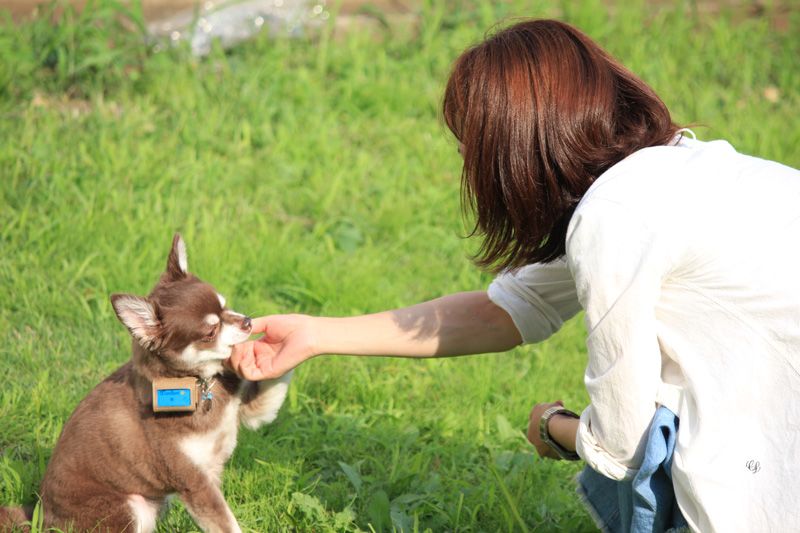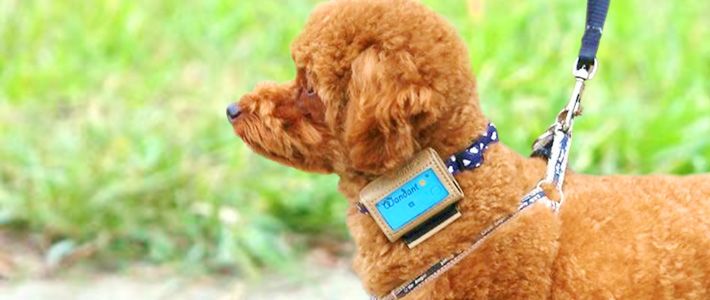
Putting Fido Through His Paces: The World’s First Pedometer for Dogs
Science Technology- English
- 日本語
- 简体字
- 繁體字
- Français
- Español
- العربية
- Русский
Dogs Get Diabetes Too
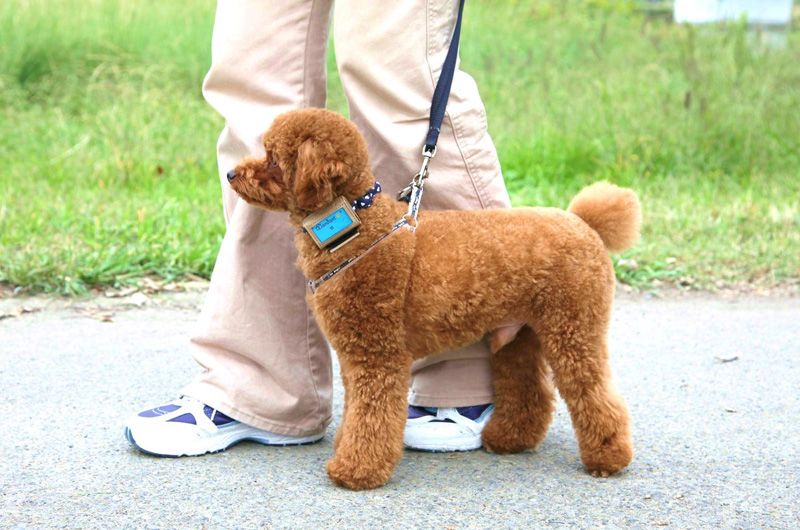 As anyone who has visited Japan recently will be aware, the country is currently in the throes of a “pet boom.” More people than ever are keeping dogs and cats at home. And living alongside humans, many of these animals are starting to suffer from the same diseases. With increasing numbers of pet owners worried about making sure their four-legged friends get sufficient exercise, Fujitsu’s new invention couldn’t have come at a better time.
As anyone who has visited Japan recently will be aware, the country is currently in the throes of a “pet boom.” More people than ever are keeping dogs and cats at home. And living alongside humans, many of these animals are starting to suffer from the same diseases. With increasing numbers of pet owners worried about making sure their four-legged friends get sufficient exercise, Fujitsu’s new invention couldn’t have come at a better time.
“In recent years, problems like obesity and diabetes have started to affect pets in much the same way as they affect people,” says Mitsuyama Yōko, a manager in the Fujitsu Ubiquitous Service Business Unit, where the “Wandant” dog pedometer was developed. When people are worried that they might not be getting enough exercise they can use pedometers as a tool in managing their health. We wondered if we couldn’t provide something similar for pets.”
Mitsuyama herself has two toy poodles she considers members of the family. Naturally, she wants to make sure they stay healthy. She says she got the idea for the new product from an earlier pedometer application Fujitsu developed for mobile phones. She proposed that the company develop a similar device for pets. Her coworkers thought it was an interesting idea—the question was: Could it be done? Eventually, her supervisor gave the project the go-ahead, saying: “Let’s try it and see.”
Canine Gait Gives Paws for Thought
Mitsuyama and her team started by collecting data on how dogs walk and run, using sensors and video cameras.
“We had no data on the gait of four-legged animals, so we spent the first six months collecting data from more than 100 dogs of all sizes,” says Mitsuyama.
The first problem was to persuade the dogs to cooperate. Sometimes the test subjects would suddenly stop still and refuse to budge; at other times they would break abruptly into a trot at inopportune moments. As soon as the dogs started running, it became impossible for the people doing the counting to keep up. Also, different sizes and breeds of dog have dramatically different stride lengths and running styles. Another problem involved the basic question of what to count as one step: the results varied widely depending on whether the researchers based their measurements on the dogs’ forelegs or the hind legs.
Through trial and error, they identified five running patterns and were finally able to agree on a fixed definition of what constituted a single step. When the dog was walking, a step was counted whenever when one of the dog’s forelegs touched the ground. In running, a step was counted when both forelegs touched the ground after being in the air.
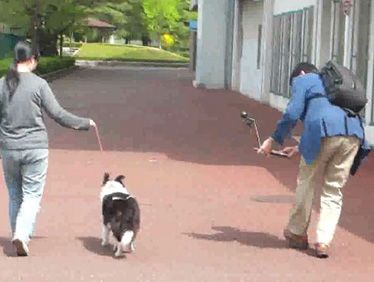 Measuring a dog’s walk with the use of sensors.
Measuring a dog’s walk with the use of sensors.
The world’s first dog pedometer combines 3D acceleration sensors that detect changes of speed on three axes—front-back, left-right, and up-down—with motion estimation technology that uses the data produces by the sensor to calculate the number of steps based on the speed and length of the dog’s forelegs. This new invention made it possible to modify the sensor technology previously developed for mobile phone applications and make it applicable to dogs. Since dogs and cats walk in quite different ways, however, the device cannot be used on cats.
As well as counting the number of steps a dog takes, the pedometer can also measure dogs’ shaking movements and the temperature around the neck. Shaking is often a sign of anxiety or stress, so measuring it accurately allows owners to keep tabs on their pet’s stress levels. Monitoring temperature changes allows owners to monitor their dog’s comfort and makes it easier to guard against heat stroke and other potential problems.
Keeping Your Pooch from Getting a Paunch
An important consideration in developing the pedometer was to make it as lightweight as possible. The pedometer works by being attached to a dog’s collar throughout the day—a heavy device will obviously not make for happy pets. Initial plans called for a GPS and liquid crystal display to be added to the device, but these were scrapped in order to reduce the weight. With the use of FeliCa technology and a small watch-type battery, the weight was kept down to just 16 grams. FeliCa is a smart card system fitted with a small IC chip, which enables exchange of data when put close to a smart phone or computer. The data are then sent to a dedicated Wandant cloud.
The Wandant is rectangular to ensure that the canine wearer does not accidentally swallow the pedometer or battery. The lid covering the battery is held in place with a screw. This makes opening and closing the cover a little more time-consuming, but developers chose to prioritize safety over convenience.
Monitoring Your Pet’s Day
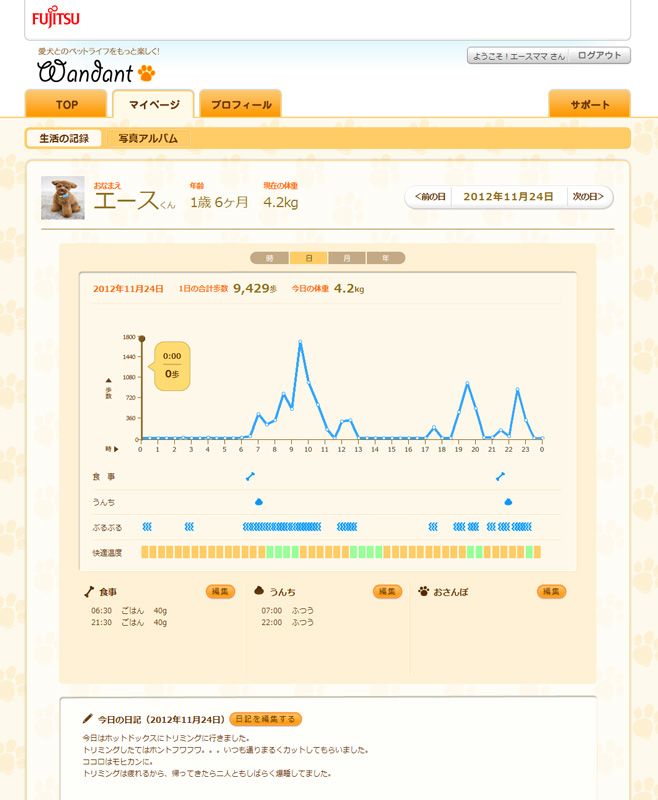 Steps are tallied each hour and shown on the graph. Large peaks indicate particularly active periods.
Steps are tallied each hour and shown on the graph. Large peaks indicate particularly active periods.
But there is more to Wandant that just the device worn around the collar: the system brings together the pedometer, a computer, and cloud computing. The pedometer’s sensors sense the dog’s movement and send the data to the cloud, where it is instantly analyzed. The number of steps walked is graphed against time, along with information showing how many times the dog shook during the period in question and the temperature around the dog’s neck.
This system allows owners to monitor their pet’s activities during the day from the graphed data. When the graph shows the number of steps to be zero, it is safe to assume that the dog was sleeping. (Either that or there is some very bad news waiting for you at home.) When the graph peaks, the owner knows that the dog was moving about energetically. The dog is not monitored constantly, but the dog’s movements throughout the day are highlighted from the data. From the graph users can imagine their dog’s activity when they were out. Some users say they look forward to checking the data when they get home.
 Mitsuyama, who helped to develop Wandant, with her beloved Ace.
Mitsuyama, who helped to develop Wandant, with her beloved Ace.
The dedicated website shows how Wandant can be used to record the amount a dog eats and monitor the changes in its condition. Some owners use Wandant as a kind of album, documenting their pet’s growth with photos and a diary.
“It’s much more than just a convenient way to manage your dog’s health,” says Mituyama. “Dogs can’t talk, but by following their behavior and activities on a daily basis you can get closer to your dog’s feelings. Wandant is a tool that will help to deepen the relationship between you and your dog.”
“Each day Wandant records your dog’s activity levels in a format that is easy to understand. This activity is one indicator you can use to monitor your pet’s state of health,” says veterinarian Tsuchiya Yoshitaka. “Nowadays a lot of people are keeping small dogs as indoor pets. Even these small dogs need a sufficient amount of exercise, but ensuring that they are getting it is difficult. We’re seeing increasing numbers of dogs that are becoming obese or have leg joint pain. If they don’t get enough exercise, dogs will develop some of the same conditions as humans. Since pets cannot manage their physical condition or go on diets by themselves, it is up to their owners to manage their health for them. The need for this kind of pet health device is likely to increase in the future.”
Fujitsu will collectively manage Wandant data in the cloud. There are plans to use the data in research on health management, pet behavior, and nutritional health.
(Originally written in Japanese by Satō Narumi.)
Nippon.com Fujitsu science technology frontier obesity diabetes health management pet dog
